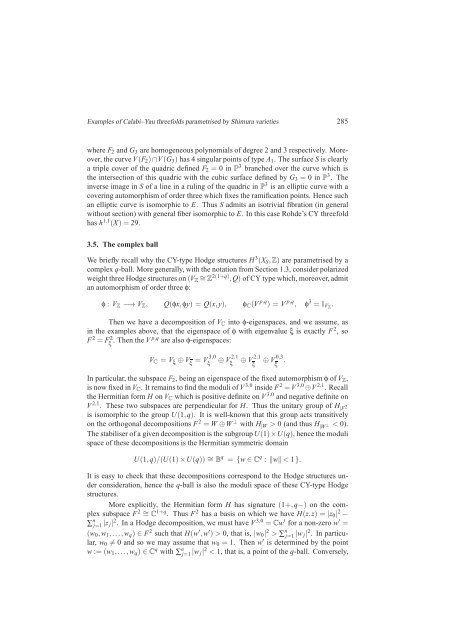Examples of Calabi-Yau threefolds parametrised by Shimura varieties
Examples of Calabi-Yau threefolds parametrised by Shimura varieties
Examples of Calabi-Yau threefolds parametrised by Shimura varieties
You also want an ePaper? Increase the reach of your titles
YUMPU automatically turns print PDFs into web optimized ePapers that Google loves.
<strong>Examples</strong> <strong>of</strong> <strong>Calabi</strong>–<strong>Yau</strong> <strong>threefolds</strong> <strong>parametrised</strong> <strong>by</strong> <strong>Shimura</strong> <strong>varieties</strong> 285where F 2 and G 3 are homogeneous polynomials <strong>of</strong> degree 2 and 3 respectively. Moreover,the curve V(F 2 )∩V(G 3 ) has 4 singular points <strong>of</strong> type A 1 . The surface S is clearlya triple cover <strong>of</strong> the quadric defined F 2 = 0 in P 3 branched over the curve which isthe intersection <strong>of</strong> this quadric with the cubic surface defined <strong>by</strong> G 3 = 0 in P 3 . Theinverse image in S <strong>of</strong> a line in a ruling <strong>of</strong> the quadric in P 3 is an elliptic curve with acovering automorphism <strong>of</strong> order three which fixes the ramification points. Hence suchan elliptic curve is isomorphic to E. Thus S admits an isotrivial fibration (in generalwithout section) with general fiber isomorphic to E. In this case Rohde’s CY threefoldhas h 1,1 (X)=29.3.5. The complex ballWe briefly recall why the CY-type Hodge structures H 3 (X S ,Z) are <strong>parametrised</strong> <strong>by</strong> acomplex q-ball. More generally, with the notation from Section 1.3, consider polarizedweight three Hodge structures on(V Z∼ =Z 2(1+q) ,Q) <strong>of</strong> CY type which, moreover, admitan automorphism <strong>of</strong> order three φ:φ : V Z −→ V Z , Q(φx,φy) = Q(x,y), φ C (V p,q ) = V p,q , φ 3 = 1 VZ .Then we have a decomposition <strong>of</strong> V C into φ-eigenspaces, and we assume, asin the examples above, that the eigenspace <strong>of</strong> φ with eigenvalue ξ is exactly F 2 , soF 2 = F 2 ξ . Then the V p,q are also φ-eigenspaces:V C = V ξ ⊕ V ξ= V 3,0ξ⊕ V 2,1ξ⊕ V 2,1ξ⊕ V 0,3 .ξIn particular, the subspace F 2 , being an eigenspace <strong>of</strong> the fixed automorphism φ <strong>of</strong> V Z ,is now fixed in V C . It remains to find the moduli <strong>of</strong> V 3,0 inside F 2 = V 3,0 ⊕V 2,1 . Recallthe Hermitian form H on V C which is positive definite on V 3,0 and negative definite onV 2,1 . These two subspaces are perpendicular for H. Thus the unitary group <strong>of</strong> H |F 2is isomorphic to the group U(1,q). It is well-known that this group acts transitivelyon the orthogonal decompositions F 2 = W ⊕W ⊥ with H |W > 0 (and thus H |W ⊥ < 0).The stabiliser <strong>of</strong> a given decomposition is the subgroup U(1)×U(q), hence the modulispace <strong>of</strong> these decompositions is the Hermitian symmetric domainU(1,q)/(U(1)×U(q)) ∼ = B q = {w∈C q : ||w|| 0, that is, |w 0 | 2 > ∑ n j=1 |w j| 2 . In particular,w 0 ≠ 0 and so we may assume that w 0 = 1. Then w ′ is determined <strong>by</strong> the pointw :=(w 1 ,...,w q )∈C q with ∑ n j=1 |w j| 2 < 1, that is, a point <strong>of</strong> the q-ball. Conversely,














